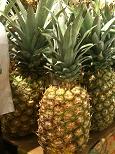OK, so I've got a problem with those numbers.
If fruit is denser than water, it should sink - but some of the fruits (coconuts, bananas, and some pineapples) used in the game float in the real world.
Still, some of them don't float - limes don't, for example. So maybe Puzzle Pirates is just making an average "fruit" object here. I can work with that (and, as a programmer, I can appreciate the simplicity of one fruit object vs. fourteen).
 |
But lets compare this generic "fruit" with some real fruits. Using the scale at Safeway, I obtained the following data: |
| Fruit | Mass (kg) | Volume Equivalent | Photo |
|---|---|---|---|
| Pineapple | 1.75 each | 2.5 softballs |  |
| Coconut | .7 each | 1.5 softballs |  |
| Mango | .4 each | 1.5 baseball |  |
| Lime | .065 each | two golf balls |  |
| Bananas | .2 each | four golf balls |  |
Obviously, these numbers are approximate - mass is a quick average of the first three (or, in the case of the bananas, seven) examples of each fruit I could grab. And I am also estimating volume, rather than figuring it out Archimedes style. Why? I'm cheap - and some of that fruit is expensive.
Speaking of volume, here's some equivalents in actual units:
- Softball: approximately .000332 cubic meters
- Baseball: approximately .000210 cubic meters
- Golf ball: approximately .00004 cubic meters
But if we allow for all that, we get the following (approximate) densities:
| Fruit | Density (kg/cubic meter) |
|---|---|
| Pineapple | 1.75/.000830 = 2108 |
| Coconut | .7/.000498 = 1405 |
| Mango | .4/.000315 = 1270 |
| Lime | .065/.00008 = 812.5 |
| Banana | .2/.00016 = 1250 |
Still not liking those numbers, but I'll live - I'm certainly not going to perform error analysis on them. No, sir. I can live with densities in the right ballpark and, for a given value of ballpark, these are ok. Now, on to what we've been waiting for: